Magazine “Russkaya Galereya - XXI Vek” (The Russian Gallery – XXI Century), № 5-6
The original article (pdf file)
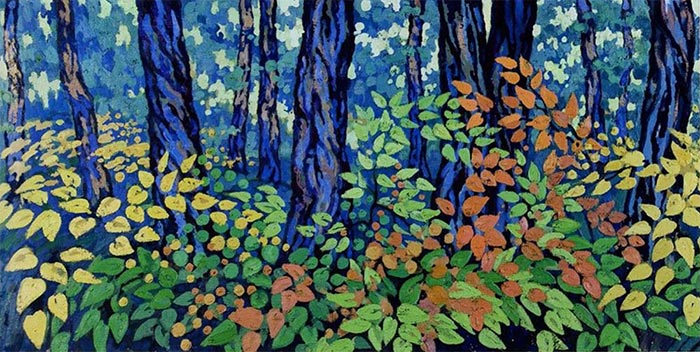
М. Syurina. Blue Forest. 2008. Canvas, oil. 50x100.
«Russian Gallery — XXI Century» magazine collection
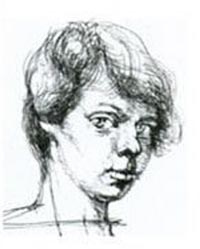
Margarita Syurina was born in the city of Bangkok (Thailand) in 1969. In 1987 she finished Tomskiy Secondary Art School in Moscow.
In 1994 she graduated from Surikov State Academic Art Institute in Moscow (the studio of T. Salakhov).
Since 1999 she has been a member of the Creative Union of Artists of Russia.
Since 2001 she has been a member of IFA.
She has taken part in Moscow and international art shows since 1988. The author's works are held in galleries, municipal and private collections in France, as well as in galleries and private collections in Russia, USA, Switzerland, and Sweden.
— Margarita, when did you start painting? And what is art to you?
— As far back as I can remember I have always painted. And I can remember myself at the age of four. I used to paint with crayons, felt pens, and watercolours, so I always used colored tools and tried to cover the whole space of the sheet. And at the age of five or six I introduced a new test in our everyday life: meeting a new person I used the first opportunity to give him a sheet of paper and felt pens saying: «Draw something for me...». If a person took a pen and drew, he at once became my friend, especially if he did it in a quick and talented manner; whereas people that refused saying they could not draw and things like that became uninteresting to me for good.
Eventually rereading «The Little Prince» by Exupery for the twentieth time I suddenly realized that when I was just five years old I took art as a means of self-expression, and what is more as a universal language of communication with people. I believe it is still so.
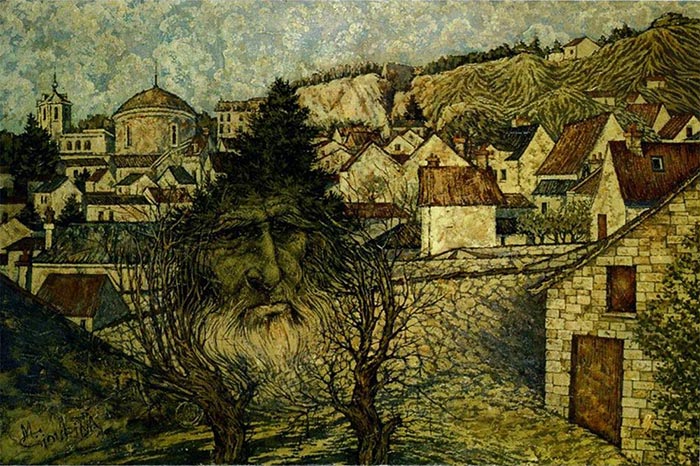
М. Syurina. Clos Luce. Leonardo. 1996. Canvas, oil. 60x90
— Who was your first teacher? And how did he influence your future creative career?
— I was lucky enough not to start studying in groups or studios. Instead my career in art began in a creative studio run by the wonderful person and painter Valentina Petrovna Tsvetkova — an Honoured Artist of the USSR and People's Artist of the Ukraine and Crimea. I met her in Yalta in 1981, when I went there to enjoy my summer holidays (my mother comes from the Crimea). Eleven-year-old, I already painted from life with watercolours and without any guidance. When Valentina Petrovna and I first went on a sketch trip, she took a large canvas to point in a brood, loose, «А La Prima» manner, and I made a small watercolour picture. Tsvetkova looked at my sketch, then at me, then at my parenls and claimed with confidence: «Your daughter should start painting seriously». That is how it all began I spent the whole summer in the studio of Valentina Petrovna, then brought an armful of works to Moscow and started getting ready for entrance exams for Moscow Secondary Art School ol Surikov Institute. Then it was the best art school in the country. Then I studied painting at Surikov Institute under the guidance ol some wonderful teachers like N. P. Khristolyubov, E. N. Troshev, T. T. Salakhov, and L. V. Shepelev.
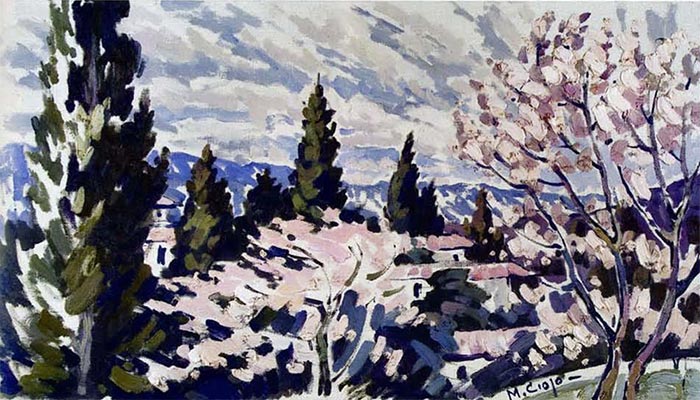
М. Syurina. Spring Wind. 2009. Canvas, oil 50x90
— Did your artist teachers of Surikov Institute somehow influence your artistic sight? And how?
— Well, of course they cid. And what is more, they formed it! Vasiliy Surikov Academic Art Institute is an extensive reliable school of mastery with the best Russian professional artists working and studying at it, which is proved by the whole history of domestic fine art. And I was lucky to study under the guidance of the best professional artists. But, you know, the first teacher is like the first love. I reckon my encounter with V. P. Tsvetkova was the brightest light-bearing and fateful encounter in my life. It was she that cultivated in me love to «А La Prima» technique and taught me the major values of art.

М. Syurina. On Seashore. 2009. Canvas, oil. 50x60.
«Russian Gallery XXI Century- magazine collection
— You normally use two painting techniques including «А La Prima» and complex multilayered, multitextured technical methods. Could you elaborate on this?
— Multilayered painting offers a lot of methods I use some like toning, spraying, and spreading paint across the canvas, as well as acrylic underlays. I always cnoose a method resting on the object I want to depict. And «А Lc Prima» term is so confusable in our art — there are so many interpretations of it nowl A lot of people confuse it with plein-air, others believe it is a synonym of a sketch and Impressionism, and some even do not consider it a technique at all. And there are so many dictionaries available now including art onesl And they are sometimes worth looking through. «А La Prima» literally means «the first touch of a brush». The painting is done quickly, effervescency in one session, on the spur of the moment. And, what is more imporlont, without any further painting or corrections. Everything should be in their respective places But it is a rare luck to do it successlullyl The method is quite difficult, since it allows of no falsehood Now I often use «А La Prima» technique, because I guess it fits my stale of mind.
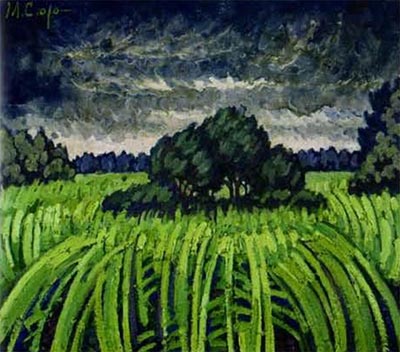
М. Syurina. Cold Summer ol 2008. 2008. Canvas, oil. 50x60.
Russ an Gallery XXI Century* magazine collection
— What are you working on now? And what would you like to show the audience in the near future?
— Now I am depicting the Crimea. I am preparing my solo exhibition dedicated to the memory of my teachers, wonderful artists like V. P. Tsvetkova, A. P. Kibalnikova, and E. N. Tarakanova. The exhibition will be held in «Ardena» Gallery and halls of the International Fund of Slavic Script and Culture in this October.
— What do you think of painting recently acquiring applied nature and serving exclusively for interior decoration?
— I feel skeptical about it Painting does not acquire anything of the kind and does not serve any such purposes. Well, of course, there is a whole lot of such opplied painters that occupy this niche and make some good money. But I do not think they are worth discussing The worst case scenario is a situation when serious talented artists panic and lose hope. I have recently argued on this subject with one brilliant wonderful painter, «Well, that is if», the artist said, «painting has gone deep into the interior underworld leaving up-to-date art to triumph and rave on stage!»
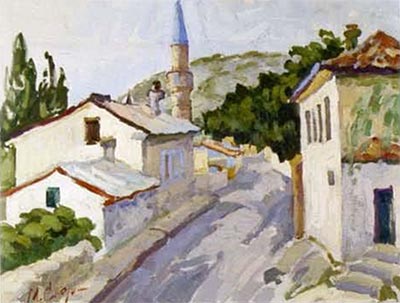
М. Syurina. Bakhchlsaray. 2008. Canvas, oil. 60x80
— Is if not true?
— The truth is that all the major Moscow and world's exhibition halls actively promote up-to-date artists, but it has nothing to do with the point of things. We can always choose whether to read the tabloids, or Pushkin, Akhmatova, and serious cultural and educational publications. And painting has always served humankind, It is a universal language to express cosmic ideas. Most great discoveries that accounted for our progress first appeared in paintings.
— How is that?
— Well, let’s lake Matisse lor example. He created his «Dance», when there were no state-of-the-art technologies. He just depicted red, green, and blue colours. And today virtually every house has a computer, digital camera, and other things. And almost every schoolboy knows that RGB is a system ol colour measurement based on three colours including red, green, and blue And it was a real breakthrough in the theory of colour. No traditional colour circle! Did you know that?
— I did not.
&mdash Neither did Matisse. He just look some information from nowhere, without any Internet, ond gave it to humankind And humankind odopted and elaborated it.
That is the idea ol the chain ortist-painling-audience. That is the objective ol art.
— And what are your objectives in art?
— My objectives have not changed. I try to reveal eternity ol new meanings in everything we come across every day. My goal is to reveal new facets of beauty and share these revelations with others, give them to the world.
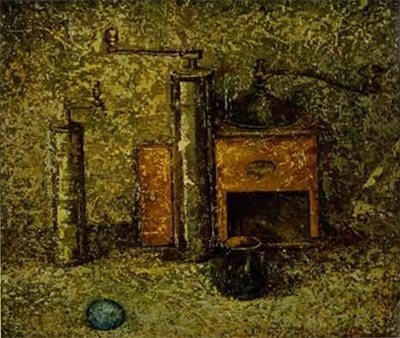
М. Syurina. Stlll-Llle with Cottee Mills. 1999. Canvas, oil. 50x60
— And what if others do not understand your gifts and the world rejects them?
— Well, then I will be like van Gogh, who used to be a jack-a- lenl ol French peasants, and today his works cost millions ol dollors ol auctions and sun-flowers appear on every tote bag. You always gel a response — sometimes earlier, ond sometimes later. When? No one con tell. But since I chose pointing os a universal language, when I was just four years old, I should speak It until the very last day
Interview by Lyudmila Kandalova
